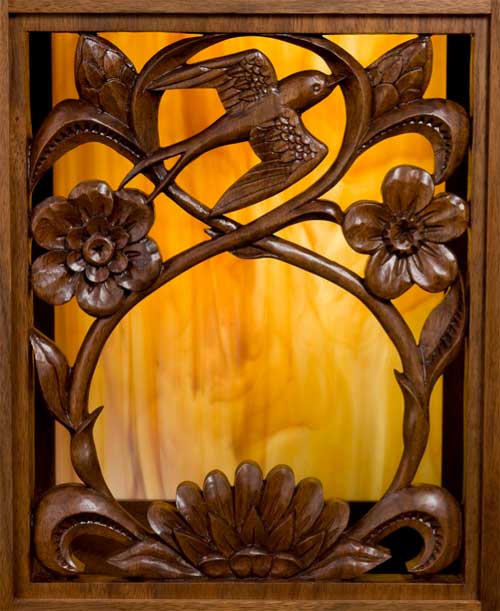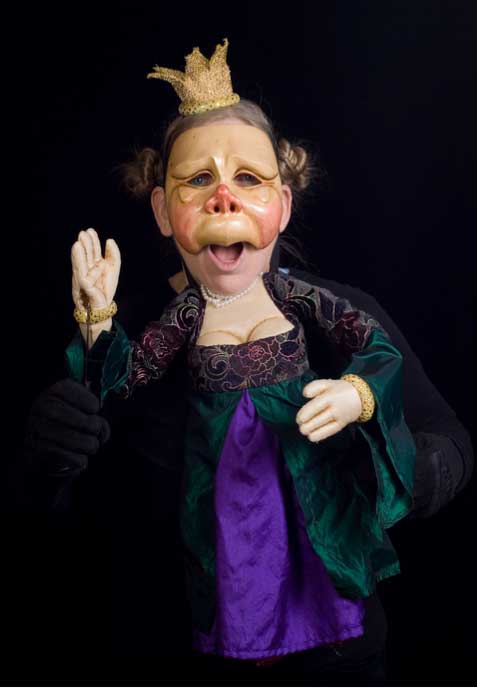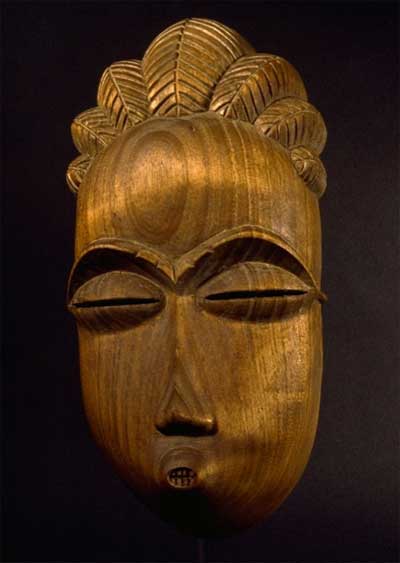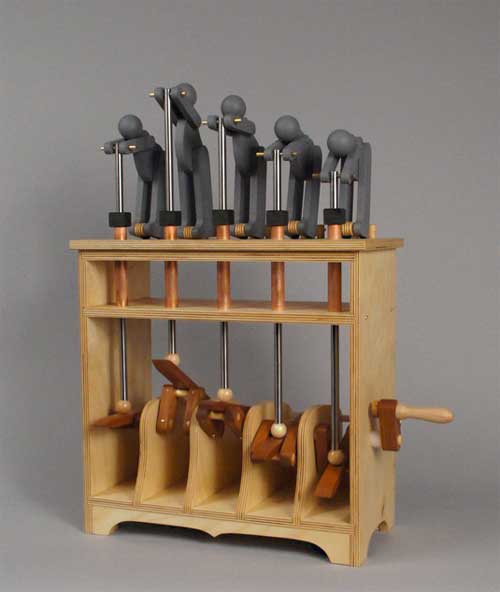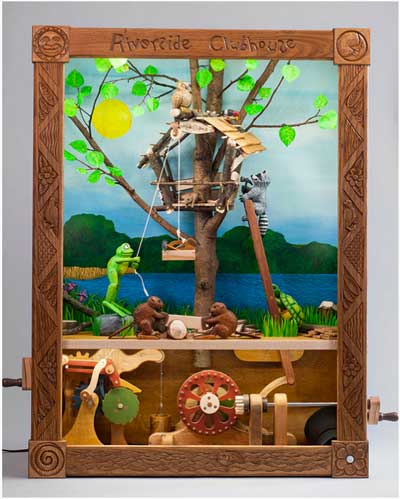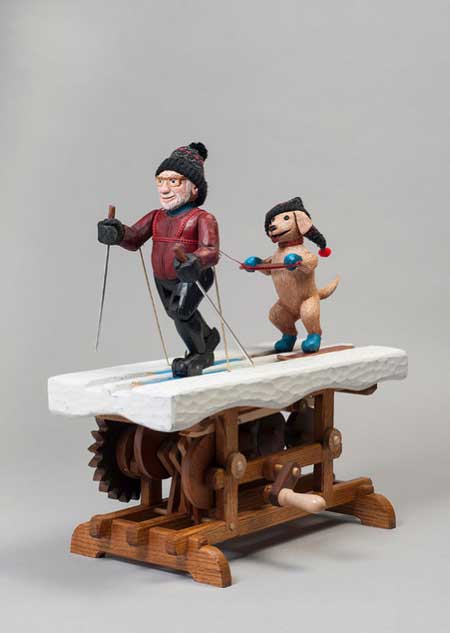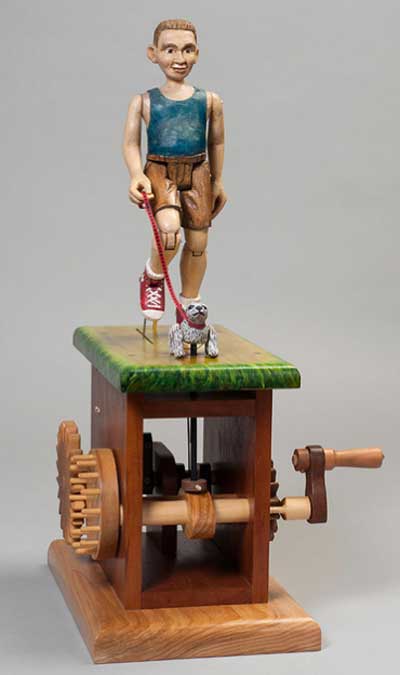
Cecilia Schiller started working with wood because it gave her more options than the materials she had been using to create theatrical masks. “I was working three-dimensionally in theater, and I got disenchanted with the alternatives I had for making things,” she said. “I wanted to learn how to carve wood, because I wanted to learn to make things out of something more innately beautiful than papier-mache or plastic.”
That desire led to a desire to learn more woodworking. Once she started carving, “I didn’t want to have to wait for other people,” she said. “Like if I wanted to make a cabinet with carving, I wanted to be able to make the cabinet and then decorate it.”
Eventually, as theater jobs started drying up during the economic downturn and Cecilia decided to open a studio and focus on her own creations, she combined the skills from both her woodworking and theater backgrounds to focus on automata: moving, interactive sculptures.
She does sometimes need to incorporate other materials, such as steel, into these objects, but “Wood is still my primary material – and what I have all the tools for,” Cecilia said.
What tools those might be depends on the project. In addition to the European style of carving, Cecilia has also trained in Balinese carving and mask performance, through travel to Bali, Indonesia for study. “While I was in Bali, I bought Balinese carving tools. I didn’t take my European style tools with me. Just like, if I study with somebody, I will just do things their way,” she said. “At this point, I’m able to incorporate different methods in my works. There are times Balinese tools work, and times when you can’t beat a chisel.”
One of the advantages, however, of the Balinese style of carving is that it solves a problem when it comes to mask-making and one particular tool: clamps. “You get to a point where there’s no place to clamp anymore, no way to secure the wood – every part of this [mask] is round,” Cecelia said. Balinese carving, in which the carver holds the wood with his or her feet while performing the carving actions, “was kind of a way to solve that,” she said. (She added that she is “pretty flexible.”)
The inspirations for her automata come from a combination of requests along a theme, and her own ideas. “I like it when it can be humorous, but sometimes it’s just really quotidian and when people see it move – like a bird flying or a horse running – people are fascinated by it,” Cecelia said.
While “Anything can work in your brain,” Cecelia said, “When you bring it into the physical world, you often find limitations you weren’t cognizant of. You still have to obey the laws of physics.”
For this reason, much of her time spent on making an automaton is focused on getting it to work. “The carving is integral, but it’s more decorative,” Cecelia said. “I depend a lot on the scroll saw, drill press and sander. Those, in combination, can get pretty precise.”
Due to the need for durability in her gears and cams, she makes them from hardwoods such as maple, cherry and walnut – which can also influence other wood choices in a piece, since Cecelia likes to go for contrasting colors. “If a cabinet is a dark wood, maybe maple can contrast with it.” For those items that will be carved, and painted, she likes basswood for its tight grain.
A recent commission for a local medical clinic does incorporate painting, into a “Riverside Clubhouse” for the types of animals that live along the river near the Park Nicollet Shakopee clinic. Almost all of the animals incorporated into the piece are species that Cecelia saw while walking along that river.
She’s also currently working on a piece, still in the concept phase, for another medical facility. That one is envisioned to have day- and nighttime aspects, with moving animals appropriate to the times, such as an owl in a tree which will stretch its wings when the “moon” comes out.
“It’s kind a combination of responding to [a client’s] needs and working with an idea,” Cecelia said.
Cecelia will be interacting with some of the public and their ideas at the Minneapolis St. Paul Mini Maker Faire® this coming weekend at the St. Paul Fairgrounds. (If you’re in town, make sure to stop by the Rockler booth for some great demos – and some Woodworker’s Journal staff, too.)
And, she recently made a piece for a friend to gift to her husband. “She said, ‘Maybe you could do Jim and the dog in some way, my two favorite beings.” As a result of discussions of favorite hobbies – and the dog’s inherent laziness – the resulting sculpture ended up being “Instead of the dog pulling the skier, I’ve got Jim pulling the dog. The dog kind of rocks back and forth while Jim the skier moves his body and arms.”
Cecelia does not consider her own pieces to be distinctly one culture or one style. “I’m also not creating anything terribly original,” she said. “My stuff comes from everything I’ve gleaned along the way.”
